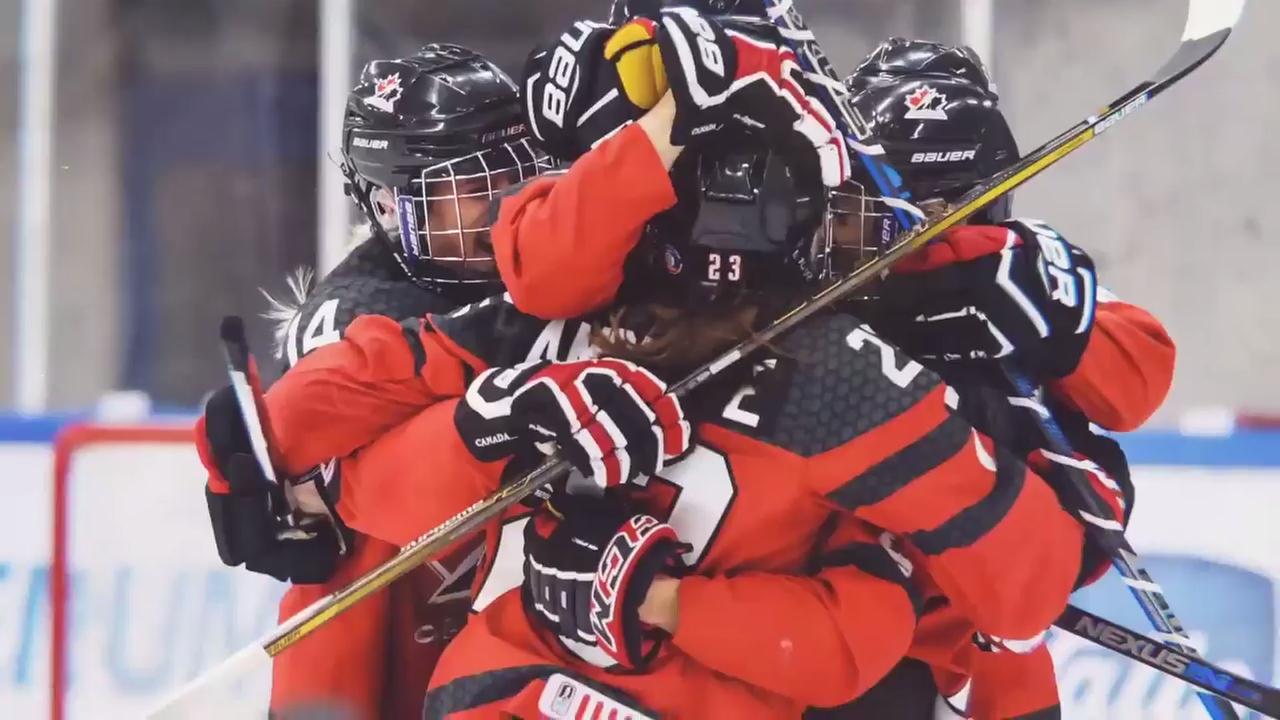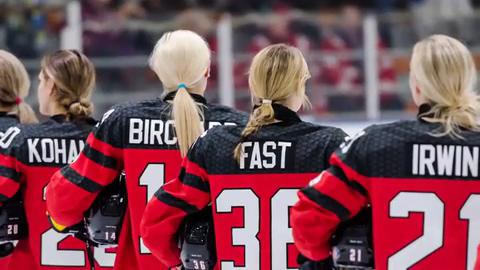
Schedule
Team Canada (Men)
IIHF World Junior Championship | Dec. 26, 2024-Jan. 5, 2025
Spengler Cup | Dec. 26-31, 2024
4 Nations Face-Off | Feb 12-20, 2025
IIHF U18 World Championship | April 23-May 3, 2025
IIHF World Championship | May 9-25, 2025
U17 World Challenge | Nov. 3-9, 2024
Hlinka Gretzky Cup | Aug. 5-10, 2024
Junior A World Challenge | Dec. 9-15, 2024
National Junior Team vs. USPORTS | Dec 12-13, 2024
Search

Made in Manitoba
Four members of Team Canada are leading the charge and helping give their Prairie province a prominent place on the women’s hockey map

Ashton Bell. Bailey Bram. Shelby Bram. Jalyn Elmes. Kayla Friesen. Ryleigh Houston. Halli Krzyzaniak. Brigette Lacquette. Jocelyne Larocque. Sheridan Oswald.
What do they all have in common?
Actually, there are a couple of acceptable answers: They’re all Manitoba natives, they all played for Team Canada in international competition this season, and – perhaps most importantly – they’re all leading a women’s hockey renaissance on the Prairies that has positioned the province as one of the biggest suppliers of talent to Canada’s national women’s program.
Bell, Elmes, Friesen, Houston, and Oswald helped Canada’s National Women’s Under-18 Team to a silver medal at the IIHF U18 Women’s World Championship on home ice in St. Catharines, Ont., last January, just days before Shelby Bram and Lacquette won gold with Canada’s National Women’s Development Team at the Nations Cup in Germany.
But nowhere is the Manitoba Movement more evident than on the roster of Canada’s National Women’s Team at the IIHF Women’s World Championship, where four Manitobans – Bailey Bram, Krzyzaniak, Lacquette, and Larocque – are proudly waving their flag.
“It’s huge,” says Larocque, the senior member of the quartet in Kamloops. “To have four representatives from Manitoba, it says a lot about the province and development, and that [Hockey Manitoba is] doing a good job.”
Indeed, much of the credit needs to go to the provincial organization; the focus within Hockey Manitoba hasn’t just been on the high-performance program, it has been on getting more girls into the game at the grassroots levels, and giving them a place to play.
That, in turn, leads to more opportunities for young girls to play on all-female teams, hopefully stay in the game longer, and maybe, just maybe, develop into the next big thing from Manitoba.
“Growing up, most of us played with the guys,” Bram says of the challenges she faced. “But it’s getting stronger and I think you really see that with Halli, who grew up playing with the girls right through, and now some of the girls coming up, like Ryleigh Houston in the U18 program, and a couple of the other girls. I think it’s come a long way, and it’s just going to get better.”
“It gets more girls interested in the game,” Krzyzaniak, a Neepawa, Man., native, adds. “For some girls, playing with the boys can be intimidating, so to have the option to play girls hockey is good for those who might be leery, helping get their feet wet and getting them into the game.”
And once they’re in, there is no shortage of options for women’s hockey in the province. The Manitoba Female Midget Hockey League is one of the strongest leagues of its kind in the country, producing a pair of Esso Cup champions; Winnipeg is home to three prep school teams, who anchor the annual Female World Sport School Challenge held in the provincial capital; and Manitoba’s under-18 program is a perennial contender at the National Women’s Under-18 Championship, winning two silver medals in the last three tournaments.
So that’s one part of the equation taken care of – opportunity. What else is necessary to help a young player’s dreams come true? How about someone to look up to? Everyone needs a role model.
Just as today’s Manitoba stars admired past Team Canada stand-outs like Jennifer Botterill, Delaney Collins, and Sami Jo Small, the next generation has its sights set on being the next Bram, Krzyzaniak, Lacquette or Larocque.
“It’s something that takes getting used to,” Bram says of her home-province stardom. “Every time someone says ‘You’re my hero, can you sign this?’ I have to take a moment and step back and realize girls do look up to us, and we are heroes and idols, and they want to be just like us.
“For me, I still come to the rink and I’m in awe of the Marie-Philip Poulins and the Hayley Wickenheisers, and so to have young girls look up to me is a special feeling.”
But it’s not just the Poulins and the Wickenheisers that Bram has looked up to; she grew up across the street from Larocque in Ste-Anne, Man., and spent her younger years revering her now-teammate.
“She was my idol growing up,” Bram says with a laugh. “She used to play with my older brothers, and I remember waiting outside the dressing room and I would ask to carry her water bottles to the bench, or her stick, and I’d also give her high-fives and give her candy after games. I’d always just follow in her footsteps, or tried to, and I was probably the annoying little girl that tried to do it just like her.”
Larocque, though, sees things just a little bit differently.
“It’s funny,” she says, “because especially at such a young age, [Bram] was better than me. She played on my team, she’d move up a level to play with me and she was better than I was. So the fact she says she looked up to me, that’s actually surprising because she was the more talented player.”
So what’s going to happen when the next generation arrives, and the future becomes the present?
From the looks of the Manitoba program, provincially and nationally, there’s no need to worry.
“Watching the U18s from the Team Manitoba level, to U18 Team Canada, to the development team, there is a lot of Manitoba representation,” Larocque says. “When I see those players, I feel a sense of pride; I feel proud for them, and proud for the province. The future is in good hands for Team Canada, and for Team Manitoba.”
For more information: |
- <
- >









































